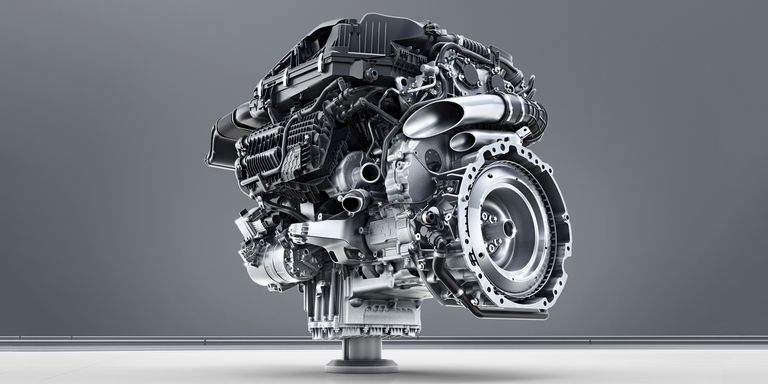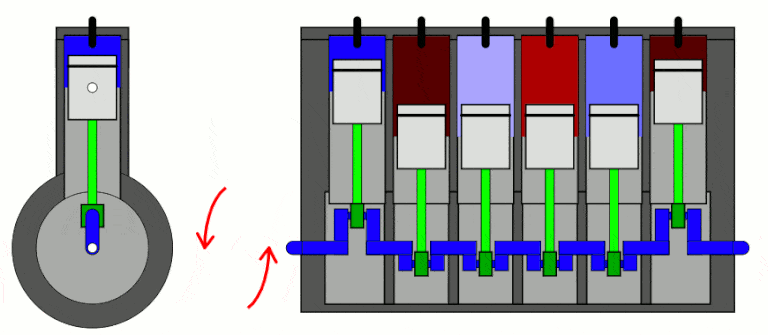
Posted on 09/06/2018 1:25:26 PM PDT by Red Badger

Once upon a time, the straight six was a dominant engine design. Jaguar put them in its best cars, Jeep built its late 20th century reputation upon them, and almost every humdrum family car or pickup truck in America had one as standard—then they nearly died out.
For years, V6 engines were killing off the straight six, also known as an I6 or inline six, and the entire design appeared destined for oblivion. But Mercedes-Benz has performed a resurrection. It brought back the straight six in the form of the M256, an entirely new engine design, to replace many of its V6s.
In the end, it was the engine’s low development costs—not the inline engine's inherent smoothness— that gave this old motor design a stay of execution. Already puttering around international markets since 2017, M256-powered Benzes arrive in the U.S. for the first time in the CLS450 sedan and AMG CLS53 grand tourer coupe later this year.
If Mercedes' newfound interest in straight sixes sticks, it could be the beginning of a comeback.
What Is a Straight Six?
“Straight” refers to the arrangement of cylinders in the engine block, and “six” refers to the number of cylinders. “V” was the arrangement that eventually superseded it, where two banks of cylinders shared space like interlocking fingers. Mercedes built its lineup heavily on straight sixes from 1924 to 1943, until the business of making Nazi war wagons got in the way. And then from 1951 and all the way through 1998, Mercedes always had at least one straight six in production.
Powerful V8s took over the American auto industry from the 1950s to the 1970s as cars grew monumentally large and gas was cheap, but if you ordered a family car, a pickup truck, or a pony car in base trim, it probably came with an I6.
But cars started shrinking in the 1980s, and engine bays got smaller as crumple zones and underhood electronics competed with engines for space. V6s, because they stagger cylinders in two opposing banks, are shorter than I6s. Engines had also become more expensive to develop, and with a V8 in most companies' lineups it made more sense to share costs by chopping off two cylinders to create a V6, and the shorter V6 fit inside engine bays more easily. Making It Fit Mercedes-Benz Sechszylinder-Benzinmotor M256 Mercedes-Benz six-cylinder engine M256. Daimler AG
Short hoods are still an issue, but Mercedes has a few tricks to shorten the M256 enough to cram it inside today's snub-nosed cars.
On a conventional engine, engine power runs the hydraulic power steering, alternator, air pump, and air conditioning compressor, and it powers them through a system of rubber belts on pulleys that hang off the front of the engine. All of it takes up a lot of valuable underhood room between the engine and the front grille. The M256 does away with belts and pulleys, and instead runs accessories such as air conditioning and the alternator through a 48-volt electrical system called the Integrated Starter-Alternator (ISG). image The 5 millionth Jeep 4.0L straight six. Wikimedia CommonsCZmarlin
It made the engine shorter, so Mercedes had an easier time fitting the M256 into its cars. ISG also incorporates an electric auxiliary compressor alongside a conventional turbocharger on the CLS53. Depending on power demands, the compressor can either help spool the turbo or provide boost directly to the engine. The combo cuts out turbo lag, the delay you feel between pushing the gas pedal and receiving the boost of power.
Today’s six-cylinder engines are often derived from other engines because you can easily lob off or add cylinders to an existing design. So that beefy V8 can be trimmed down to a V6 or a lean I4 can add some muscle and become an I6. For example, General Motors Vortec V6 was just a small-block V8, lightly pruned. This approach avoids redundant design, and more importantly, added costs.
These more-compact V6 designs had been displacing I6s for 20 years. When Mercedes ended production of the W140 S-Class in 1998, the M104—the company’s last I6—died with it. By then most car makers had long-since replaced straight six gasoline motors in their light passenger vehicles.
Entering the 21st century, hardly anyone made inline sixes. Jeep killed off its AMC-derived 4.0L I6 after 2006 in favor of V6s. General Motors, unique for its time, created an I6 in 2002 as part of its new Atlas engine family, which lasted until 2012. Only BMW continued to build much of its lineup on the straight six. Smaller Engines, More Power image Mercedes-Benz 2019 CLS450 sedan Daimler AG
But the demand for bigger engines that consumed the 1980s and ‘90s have been tempered by engineers squeezing more power out of less cylinders. Because of growing climate change concerns, automakers are under pressure to design more fuel-efficient engines, and V8s tend to take in and burn more fuel than smaller-displacement four- and six-cylinder engines. It also helps that today's sixes can out-muscle a lot of V8s from just ten years ago. Smart Your Engine Infiniti QX50 How Infiniti's Variable-Compression Engine Works 4-cylinder engine for chevy silverado and gmc sierra Four-Cylinders Are Coming to Full-Size Trucks image How a Knocking Engine Also Mean Auto Innovation
So rather than design a clean-sheet V6 to replace its outgoing and dated V6s, Mercedes created a modular engine family based around half-liter cylinders, which could be built into 2.0L fours (M254) and 3.0L sixes (M256). The M256 makes 362 horsepower and 369 foot-pounds of torque in the CLS45, and 429 horsepower and 384 foot-pounds of torque in the CLS53—those are V8 numbers.
It’s this industry-wide engine downsizing that could be giving straight sixes new life. Jaguar and Land Rover, owned by Indian Tata Motors Limited since 2008, are co-developing a new I6 to replace their V6s for the same reasons as Mercedes.
Mercedes' return to its dormant, dusty roots as a straight-six car company is more than a tentative step. The automaker has invested a significant amount of money into an entirely new engine family to run the majority of its lineup for years to come. So for now, the straight six isn't going anywhere. 
Animation of an inline straight-six engine. Wikimedia CommonsMichael Frey
.
If you did much towing, the Ford I6 was much better than the small V8. It had massive low-end torque.
.
I bought a 70 nova in high school with a straight 6. I built a 454 gmc truck engine with the tall deck. When time came to yank out the straight 6 I took bets on how long it would run with a brick on the gas pedal after draining the coolant and oil. The longest bet was maybe three minutes. It ran almost 20. It was winter time. It locked up. During the time it ran it through a rod and still ran. After the show it was going in the garage. We hit the key for giggles and it started up again.
Gone the way of the Pontiac straight 8.
There are no high performance, racing, sport or luxury front wheel drive cars. Some are all wheel drive but none just front wheel drive. I wonder why?
I had an old f150 with that fine old 300 six. That truck went almost 700k miles. Had the non Fowler inserts but ran fine. The frame finally rusted out.

The mother of all L-6 engines.
roducing up to 385 horsepower and 900 pound-feet of clean diesel torque
Good story.
Forever 153624
I loved the old Dodge 225.
.
Most front drive cars drive quirkey, and they are frightfully costly to repair.
My wife has an all wheel drive Escape that is pleasant to drive, but when a piece of newspaper blocked the Trans cooler, it cost $4000+ to fix it!
.
Toyota's 2JZ GTE Turbo I6 engine was the base for many garage hobbyists in their quest to be a part of the "1000 hp Supra" club.
Front wheel only cars are limited to 300 HP. After that, the torque steer is too much.
That animation has the inline cylinders firing in pairs, as though it were a V. Did the old inline sixes fire like that? I never actually checked it out. I assumed that the cylinders each fired sequentially; but not in inline order. My ‘63 Chebby 3/4T 6 cyl. pick-em-up was a real workhorse.
.
I have a 1.6L Mazda 323 that I use for a runaround car.
Driving it in the rain is insane.
Driving it in loose gravel is guaranteed to scare you to death.
But 28 MPG is hard to pass up.
.
The article mentions GM putting out a straight 6 in 2002. I have one in my Envoy. Yeah, peppy little motor.
Freegards
Oooooh! Am I ever embarrassed! That animation is NOT firing in pairs. I hope I just had TEMPORARY insanity.
A crate in line 6 will go in the project CJ7.
The engine was blown when I got it a few years ago.
As much as I would love an AMC V8, they’re just too high.
I didn’t say anything................but............
The Buick 225 V6 was a little but peppy motor.
But Chevrolet had straight sixes from (I think) about 1929 until 1954. Ford started producing I6es in the 1960s, and had them even in the Mustang body. I had one of the I6 F150s for 15 years, a much better engine than the V6, IMHO.
Disclaimer: Opinions posted on Free Republic are those of the individual posters and do not necessarily represent the opinion of Free Republic or its management. All materials posted herein are protected by copyright law and the exemption for fair use of copyrighted works.